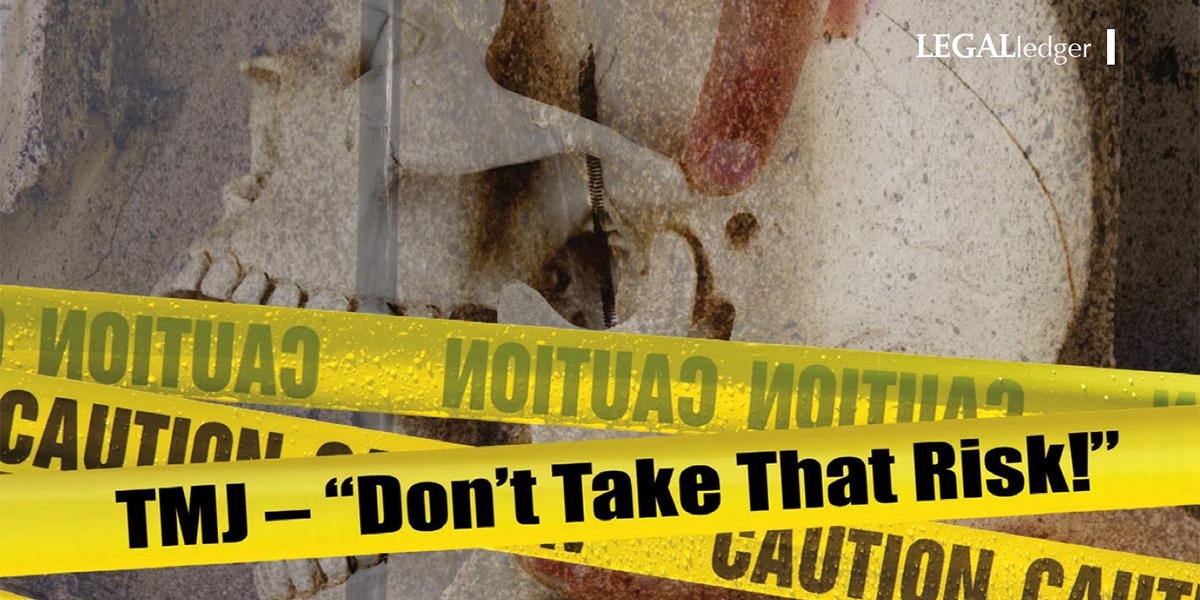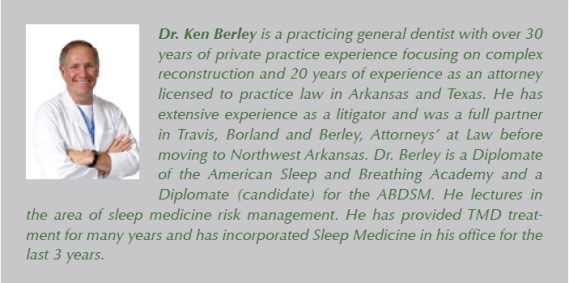
As you know by now, this issue is dedicated to TMD complications secondary to Oral Appliance Therapy. I have resisted writing on this subject because it is so complicated and difficult to adequately cover in a short article. However, upon request and hereby and forever under protest, I will attempt to cover this subject as efficiently as possible in the space I have available. From a legal perspective, TMD dysfunction secondary to Oral Appliance Therapy is problematic given that some medical insurance companies restrict the fabrication of an Oral Appliance for the treatment of OSA if the patient has TMD. Additionally, if care is not taken when TMD dysfunction develops secondary to Oral Appliance Therapy, the treating dentist could find himself party to a malpractice action for damaging the temporomandibular joint.
“WARNING!” Temporomandibular Joint Dysfunction it is one of the listed complications in the 2005 AADSM Practice Parameters article.
Practice Parameters for the Treatment of Snoring and Obstructive Sleep Apnea with Oral Appliances: An Update for 2005 An American Academy of Sleep Medicine Report
3.4.3 …….. “Oral appliances may aggravate temporomandibular joint disease and may cause dental misalignment and discomfort that are unique to each device.”
It is very unfortunate from a legal perspective that TMD is listed as a known complication of OAT. By listing TMD as a complication of OAT in a practice parameters document all dentists practicing Dental Sleep Medicine are thereby placed on legal notice that worsening or aggravation of TMD is a “foreseeable” consequence of mandibular advancement therapy. Foreseeability creates a “Legal Duty” to protect the patient from developing the foreseeable complication and a legal requirement that we use all reasonable means to prevent the complication from occurring.
So the question is: “If your patient has ANY signs or symptoms of TMD at your initial exam, is it malpractice to provide Oral Appliance Therapy?” CAUTION! A jury could determine that YOU negligently breached the alleged “Standard of Care” for proceeding with OAT if the patient has TMD symptoms at intake.
“Would a reasonable and prudent practitioner, who is on notice that treatment can exacerbate Temporomandibular Joint Dysfunction, proceed with MAD therapy?” Obviously this would be a question for a jury to decide. Personally, I don’t want to be the dentist in court defending my actions because I provided treatment on a patient who had TMD symptoms at intake! So I refuse to take that risk!
Since the 2005 Practice Parameters places us on legal notice that our treatment with a mandibular advancement device can “aggravate temporomandibular joint disease,” if your patient has ANY TMD symptoms isn’t it the legally prudent course to refrain from treating these patients? The problem with this approach is that, from my observation, almost all OSA patients have some signs of TMD. Some definitions of TMD include ALL patients with any joint sounds. The last time I checked this may be 75% or more of the population. If we are forced to eliminate patients with ANY joint sounds, we would never treat any patients.
 So how have I resolved this dilemma? I insist that the patient assume the risk for his or her joint issues. As I said, I refuse to take the risk of TMD. In my practice, I document ALL TMD signs and symptoms. I do a complete history and I palpate all muscles of mastication and record tenderness. I do complete range of motion measurements and I document all joint sounds. I routinely palpate the origin of the lateral pterygoid intraorally and on the majority of OSA patients I discover this muscle to be inflamed. Obviously, my examination frequently uncovers symptoms of TMD. At that point, I discuss with the patient the fact that some dentists believe that patients with TMD symptoms are at a greater risk for joint pain and soreness when their OSA is treated using Mandibular Advancement Devices. I explain that I personally believe that TMD symptoms are generally improved by MAD therapy and not made worse but because TMD is listed as a “complication” in our practice parameters, I cannot proceed with treatment unless they are willing to assume the risk that the Mandibular Advancement Device may cause problems with the Temporomandibular Joint. I inform the patient that in my opinion they may have more initial joint tenderness than some patients, but these symptoms generally resolve with time, however, I cannot guarantee that will happen. Additionally, I remind the patient that if we don’t proceed with MAD therapy their only option may be CPAP or surgery. At that point I make a note in the patient’s record that the patient has been informed of the risk associated with treating his or her OSA in the presence of TMD symptoms and the patient has agreed to assume the risk. I then have the patient sign the record.
So how have I resolved this dilemma? I insist that the patient assume the risk for his or her joint issues. As I said, I refuse to take the risk of TMD. In my practice, I document ALL TMD signs and symptoms. I do a complete history and I palpate all muscles of mastication and record tenderness. I do complete range of motion measurements and I document all joint sounds. I routinely palpate the origin of the lateral pterygoid intraorally and on the majority of OSA patients I discover this muscle to be inflamed. Obviously, my examination frequently uncovers symptoms of TMD. At that point, I discuss with the patient the fact that some dentists believe that patients with TMD symptoms are at a greater risk for joint pain and soreness when their OSA is treated using Mandibular Advancement Devices. I explain that I personally believe that TMD symptoms are generally improved by MAD therapy and not made worse but because TMD is listed as a “complication” in our practice parameters, I cannot proceed with treatment unless they are willing to assume the risk that the Mandibular Advancement Device may cause problems with the Temporomandibular Joint. I inform the patient that in my opinion they may have more initial joint tenderness than some patients, but these symptoms generally resolve with time, however, I cannot guarantee that will happen. Additionally, I remind the patient that if we don’t proceed with MAD therapy their only option may be CPAP or surgery. At that point I make a note in the patient’s record that the patient has been informed of the risk associated with treating his or her OSA in the presence of TMD symptoms and the patient has agreed to assume the risk. I then have the patient sign the record.
Legally if the patient has signed an informed consent that states that developing or worsening TMD symptoms is a possible complication with MAD therapy, then signs your record stating that he/she has been informed of this risk and forever assumes this risk and releases you of liability for this complication, you should be free to treat this patient. Having the patient assume this risk does not mean that the patient cannot sue, however, winning that suit would be very difficult and most plaintiff’s attorneys would not want to be involved.
The next problem associated with TMD is that some of the insurance companies prohibit Oral Appliance Therapy on patients with TMD signs or symptoms.
For example: Arkansas Blue Cross and Blue Shield Coverage Policy Manual states:
Intraoral appliances (tongue retaining devices or mandibular advancing/positioning devices) meets primary coverage criteria of effectiveness and is covered in patients with OSA under the following conditions:
- OSA defined by an apnea/hypopnea index (AHI) of at least 15 per hour or an AHI of at least 5 events per hour in a patient with excessive daytime sleepiness or unexplained hypertension, AND
- A trial with CPAP has failed or is contraindicated, AND
- The device is prescribed by a treating physician, AND
- The device is custom-fitted by qualified dental personnel, AND
- There is absence of temporomandibular dysfunction or periodontal disease.
What a mess! How much TMD is too much? What definition of TMD do we apply to disqualify patients due to the presence of this condition? Obviously this paragraph was written by someone who does not do TMD exams on all sleep apnea patients, because the majority of patients would be disqualified. Therefore, from a legal perspective, if we treat a patient with ANY symptoms of TMD, are we committing insurance fraud? This risk is real! If we document any signs of TMD we may be providing treatment to patients who do not qualify for insurance coverage. If we then file a medical insurance claim, we could be accused of fraud. As we all are aware, fighting a claim of insurance fraud is a no-win situation. The medical insurance company has every legal right to audit your records and demand any payments to be returned to the company. Additionally, if the insurance company can prove that you intentionally defrauded the company, criminal charges could be filed. If we don’t document TMD status in our intake examination we run the risk of being accused of damaging the temporomandibular joint during treatment if the patient develops clinically significant symptoms. In other words, if you don’t document the existing signs and symptoms that are present during your initial examination you leave yourself open to attack. If the patient suddenly develops significant TMD symptoms you then might be vulnerable in a malpractice suit alleging that you caused TMD dysfunction by over-titrating or excessively titrating your patient. So what do we do?

The first thought that comes to mind is a Class Action suit against all insurance companies that restrict care for patients with OSA, but that discussion is for my attorney friends. In my office, I document ALL TMD signs and symptoms. Then I decide if the TMD signs and symptoms uncovered in my examination necessitate a diagnosis of TMD dysfunction requiring treatment of the condition. In other words, how much TMD is too much? If the symptoms are not significantly serious enough to require treatment at the time of my intake exam, then it is my legal opinion that the TMD symptoms do not rise to the level that disqualifies the patient from OAT. Therefore, if the patient does not have a level of disease that requires treatment, they are not disqualified under their insurance policy. Obviously, my opinion has not been tested in court, therefore, we do not have a legal precedent to guide our decisions. “CAUTION!! Proceed at Your Own Risk!” With that being said, I document TMD signs but I do not offer a diagnosis of TMD and I do not recommend any treatment. Therefore, if the patient has the TMD restriction in their Medical Insurance Policy, I place the following paragraph in my records:
“The patient is aware that he/she may have some signs and symptoms of TMD disorder but Dr. Berley feels the symptoms do not rise to the level of a diagnosis of Temporomandibular Joint Dysfunction nor do the symptoms require treatment at this time. Therefore these symptoms in Dr. Berley’s opinion would not contraindicate oral appliance therapy.”
In conclusion, dentists practicing Dental Sleep Medicine must be aware of the risk associated with TMJ including malpractice and insurance fraud. The prudent practitioner will proceed with caution and develop a strategy to manage this risk.



